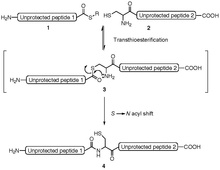Proteinligation
Die Proteinligation (englisch protein ligation) ist eine biochemische Methode der Proteinsynthese durch Verknüpfung von zwei oder mehreren Peptiden.
Eigenschaften
Durch die Proteinligation können zwei Peptide aneinander gekoppelt werden. Verschiedene Verfahren zur Proteinligation wurden beschrieben, z. B. die native chemical ligation, der Prior Thiol Capture, die Expressed Protein Ligation,[1] das Acyl-Initiated Capture, die SEA native peptide ligation, die Intein-Kopplung und die Peptidligation mit Selenocystein.[2]
Native chemical ligation

Das N-terminale Peptid muss für die Proteinligation als letzte Aminosäure (an seinem C-Terminus) ein Thioester und das C-terminale Peptid muss für die Proteinligation als erste Aminosäure (an seinem N-Terminus) ein Cystein aufweisen.[3][4]
SEA native peptide ligation
Das N-terminale Peptid muss für die Proteinligation als letzte Aminosäure (an seinem C-Terminus) eine bis(2-Sulfanylethyl)aminogruppe (SEA) und das C-terminale Peptid muss für die Proteinligation als erste Aminosäure (an seinem N-Terminus) ein Cystein oder Homocystein aufweisen.
Geschichte
Die zugrundeliegende Reaktion der native chemical ligation wurde 1953 von T. Wieland veröffentlicht.[5] Ab 1994 wurde die Reaktion zur Erzeugung von Proteinen aus Peptiden durch S. B. Kent weiterentwickelt.[6][7]
Einzelnachweise
- ↑ T. W. Muir, D. Sondhi, P. A. Cole: Expressed protein ligation: a general method for protein engineering. In: Proceedings of the National Academy of Sciences of the United States of America. Band 95, Nummer 12, Juni 1998, ISSN 0027-8424, S. 6705–6710. PMID 9618476, PMC 22605 (freier Volltext).
- ↑ B. L. Nilsson, M. B. Soellner, R. T. Raines: Chemical synthesis of proteins. In: Annual review of biophysics and biomolecular structure. Band 34, 2005, ISSN 1056-8700, S. 91–118, doi:10.1146/annurev.biophys.34.040204.144700. PMID 15869385, PMC 2845543 (freier Volltext).
- ↑ T. W. Muir, P. E. Dawson, S. B. Kent: Protein synthesis by chemical ligation of unprotected peptides in aqueous solution. In: Methods in enzymology. Band 289, 1997, ISSN 0076-6879, S. 266–298. PMID 9353726.
- ↑ T. M. Hackeng, J. H. Griffin, P. E. Dawson: Protein synthesis by native chemical ligation: expanded scope by using straightforward methodology. In: Proceedings of the National Academy of Sciences of the United States of America. Band 96, Nummer 18, August 1999, ISSN 0027-8424, S. 10068–10073. PMID 10468563, PMC 17843 (freier Volltext).
- ↑ T. Wieland, E. Bokelmann, L. Bauer, H. U. Lang, H. Lau, W. Schafer: Polypeptide syntheses. VIII. Formation of sulfur containing peptides by the intramolecular migration of aminoacyl groups. In: Liebigs Ann Chem. Band 583, 1953, S. 129–149.
- ↑ P. E. Dawson, T. W. Muir, I. Clark-Lewis, S. B. Kent: Synthesis of proteins by native chemical ligation. In: Science (New York, N.Y.). Band 266, Nummer 5186, November 1994, ISSN 0036-8075, S. 776–779. PMID 7973629.
- ↑ S. Kent: Total chemical synthesis of enzymes. In: Journal of peptide science : an official publication of the European Peptide Society. Band 9, Nummer 9, September 2003, ISSN 1075-2617, S. 574–593, doi:10.1002/psc.475. PMID 14552420.